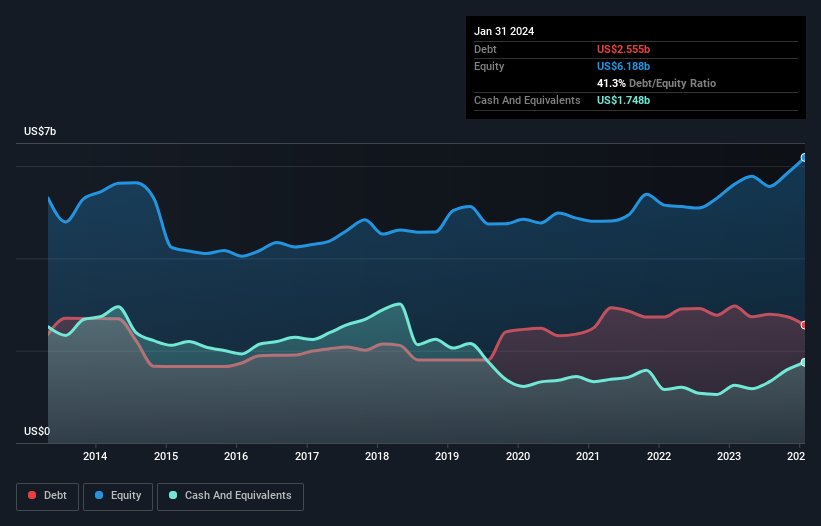- United States
- /
- Life Sciences
- /
- NYSE:A
These 4 Measures Indicate That Agilent Technologies (NYSE:A) Is Using Debt Reasonably Well

David Iben put it well when he said, 'Volatility is not a risk we care about. What we care about is avoiding the permanent loss of capital.' When we think about how risky a company is, we always like to look at its use of debt, since debt overload can lead to ruin. We can see that Agilent Technologies, Inc. (NYSE:A) does use debt in its business. But is this debt a concern to shareholders?
When Is Debt A Problem?
Generally speaking, debt only becomes a real problem when a company can't easily pay it off, either by raising capital or with its own cash flow. Ultimately, if the company can't fulfill its legal obligations to repay debt, shareholders could walk away with nothing. However, a more common (but still painful) scenario is that it has to raise new equity capital at a low price, thus permanently diluting shareholders. Of course, plenty of companies use debt to fund growth, without any negative consequences. When we examine debt levels, we first consider both cash and debt levels, together.
See our latest analysis for Agilent Technologies
How Much Debt Does Agilent Technologies Carry?
The image below, which you can click on for greater detail, shows that Agilent Technologies had debt of US$2.56b at the end of January 2024, a reduction from US$2.97b over a year. However, because it has a cash reserve of US$1.75b, its net debt is less, at about US$807.0m.

How Strong Is Agilent Technologies' Balance Sheet?
We can see from the most recent balance sheet that Agilent Technologies had liabilities of US$1.62b falling due within a year, and liabilities of US$3.14b due beyond that. On the other hand, it had cash of US$1.75b and US$1.30b worth of receivables due within a year. So its liabilities total US$1.72b more than the combination of its cash and short-term receivables.
Given Agilent Technologies has a humongous market capitalization of US$42.1b, it's hard to believe these liabilities pose much threat. Having said that, it's clear that we should continue to monitor its balance sheet, lest it change for the worse.
In order to size up a company's debt relative to its earnings, we calculate its net debt divided by its earnings before interest, tax, depreciation, and amortization (EBITDA) and its earnings before interest and tax (EBIT) divided by its interest expense (its interest cover). Thus we consider debt relative to earnings both with and without depreciation and amortization expenses.
Agilent Technologies's net debt is only 0.49 times its EBITDA. And its EBIT covers its interest expense a whopping 42.9 times over. So we're pretty relaxed about its super-conservative use of debt. It is just as well that Agilent Technologies's load is not too heavy, because its EBIT was down 20% over the last year. When it comes to paying off debt, falling earnings are no more useful than sugary sodas are for your health. There's no doubt that we learn most about debt from the balance sheet. But ultimately the future profitability of the business will decide if Agilent Technologies can strengthen its balance sheet over time. So if you're focused on the future you can check out this free report showing analyst profit forecasts.
Finally, a business needs free cash flow to pay off debt; accounting profits just don't cut it. So we clearly need to look at whether that EBIT is leading to corresponding free cash flow. Over the last three years, Agilent Technologies recorded free cash flow worth a fulsome 88% of its EBIT, which is stronger than we'd usually expect. That positions it well to pay down debt if desirable to do so.
Our View
Happily, Agilent Technologies's impressive interest cover implies it has the upper hand on its debt. But we must concede we find its EBIT growth rate has the opposite effect. Looking at all the aforementioned factors together, it strikes us that Agilent Technologies can handle its debt fairly comfortably. On the plus side, this leverage can boost shareholder returns, but the potential downside is more risk of loss, so it's worth monitoring the balance sheet. The balance sheet is clearly the area to focus on when you are analysing debt. However, not all investment risk resides within the balance sheet - far from it. Be aware that Agilent Technologies is showing 1 warning sign in our investment analysis , you should know about...
Of course, if you're the type of investor who prefers buying stocks without the burden of debt, then don't hesitate to discover our exclusive list of net cash growth stocks, today.
New: Manage All Your Stock Portfolios in One Place
We've created the ultimate portfolio companion for stock investors, and it's free.
• Connect an unlimited number of Portfolios and see your total in one currency
• Be alerted to new Warning Signs or Risks via email or mobile
• Track the Fair Value of your stocks
Have feedback on this article? Concerned about the content? Get in touch with us directly. Alternatively, email editorial-team (at) simplywallst.com.
This article by Simply Wall St is general in nature. We provide commentary based on historical data and analyst forecasts only using an unbiased methodology and our articles are not intended to be financial advice. It does not constitute a recommendation to buy or sell any stock, and does not take account of your objectives, or your financial situation. We aim to bring you long-term focused analysis driven by fundamental data. Note that our analysis may not factor in the latest price-sensitive company announcements or qualitative material. Simply Wall St has no position in any stocks mentioned.
About NYSE:A
Agilent Technologies
Provides application focused solutions to the life sciences, diagnostics, and applied chemical markets worldwide.
Excellent balance sheet second-rate dividend payer.
Similar Companies
Market Insights
Community Narratives



